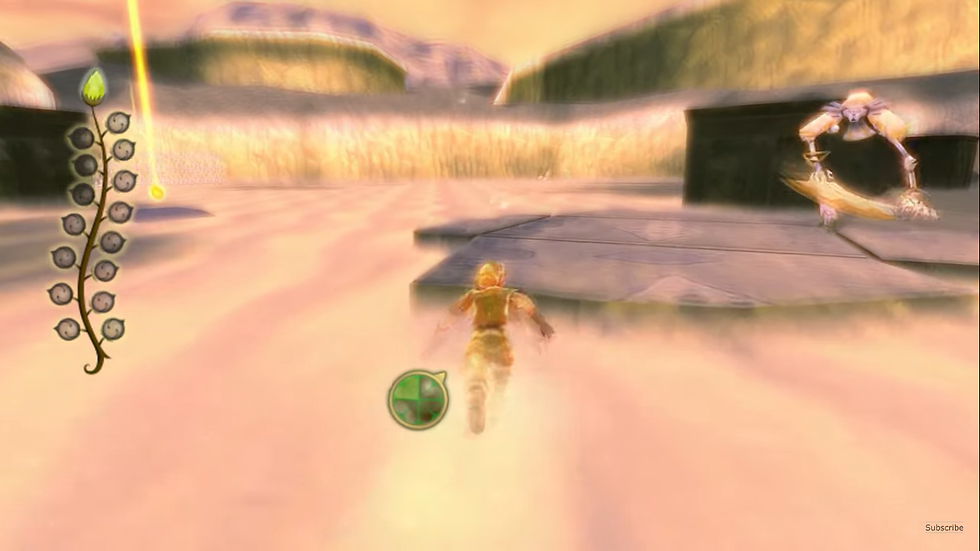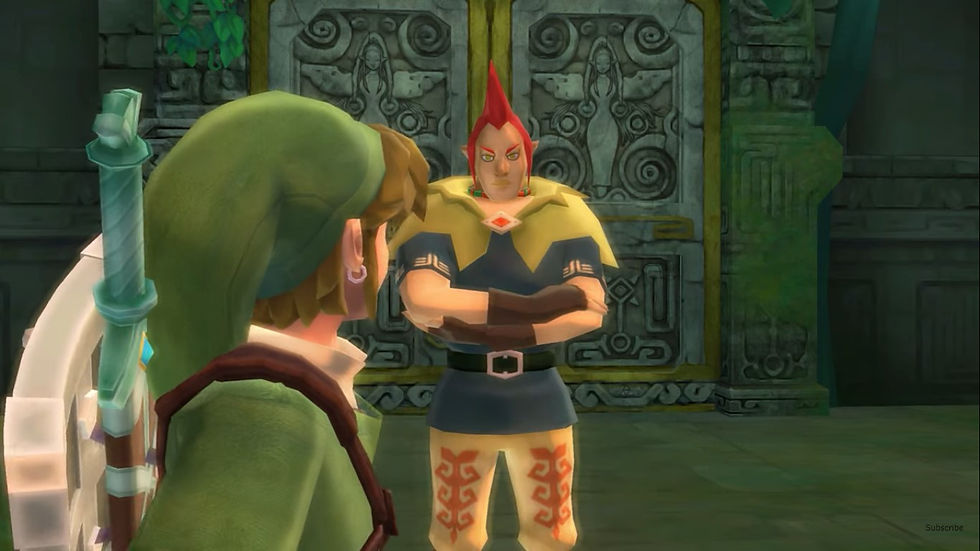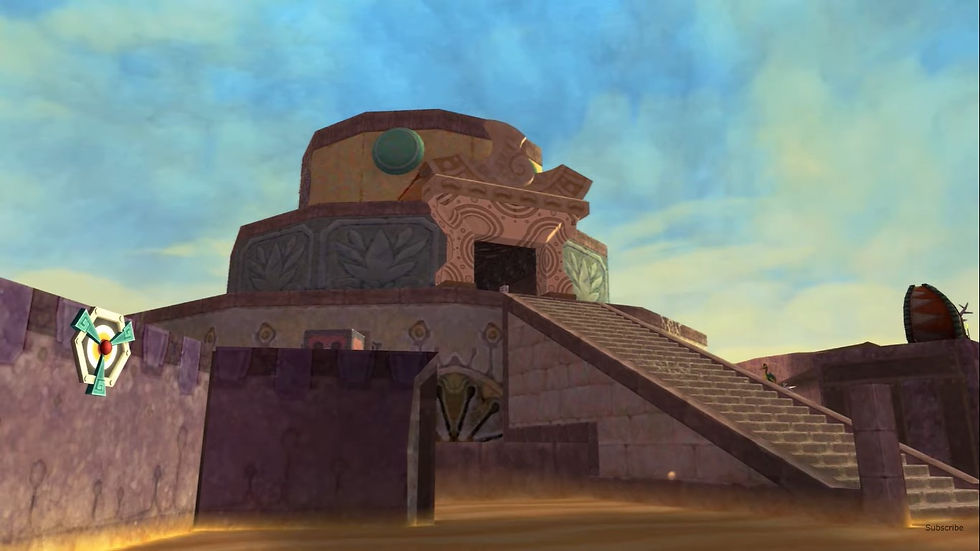Field Note #13: Zelda After Dark – Horror Elements in Skyward Sword
- The Wolfess

- Sep 23, 2020
- 8 min read

Base Stats:
Game: Skyward Sword
Version: Original Wii Version, Physical Copy
System: Nintendo Wii U
Session Play Time: 2 hr 29 min
Total Play Time: 23 hrs 32 mins
Content Covered: Sidequests, Isle of Songs #2, Silent Realm #2, Lanayru Desert #2, Sand Sea Entrance
Fi Report: 7 Forced Interruptions
Wiping sand and sweat from his brow, Link approached the familiar glowing spot on the ground. His pulse raced in his ears. The last time he attempted the Goddess’s trial in the mysterious Silent Realm, he almost didn’t make it back. His palms sweated more from nerves than the desert heat. Link could almost hear the scraping of giant blades behind his head as he positioned the Goddess Sword over the symbol that would start his second trial. It had been too close before, and he didn’t know if he would make it back this time. But if he wanted to see Zelda again, he would have to try.

Before the word “guardian” brought up mental images of spider-like sheikah mechanical automations and terrifying piano music, the word stuck true terror into the hearts of Skyward Sword players. Informed that we must refine our souls in the trials set forth by each of the Goddesses, players innocently made their way to the four trials known as the Silent Realm trials. Transported to a beautiful, haunting otherworld with strange glowing figures and silvery water, the place seems strange but peaceful when we first arrive. That wrongful impression is soon squashed when the player takes their first step out of the protective circle and all the Silent Realm guardians come to life.
Being chased by a Silent Realm guardian is a truly terrifying experience. In their dormant form they are still as statues and harmless, despite the giant weapons they carry. Every time Link picks up a tear of light, he is given a meter on the screen that counts down how much time he has to find the next one. If the timer runs out before Link has found the next tear of light, then he is in trouble. The guardians are awake, and they’re out for his blood.

The first sensation that we hear after the timer runs out is a terrifying sound, as if some mechanical monster has been activated. All the world turns to a hyper-vivid gold color, as if the whole place were overexposed in a yellow-orange light. It is the exact opposite of the color scheme it normally has, and the sudden change is jarring. The overexposure also makes it hard to see, making it disorienting to try to move around. A terrible music starts up that seems more at home to a Silent Hill game than a Zelda game.
Worse than all that, though, is the near-constant sound of swords scraping behind your head. It gets louder the closer they get. Sometimes you can even catch them in your peripheral vision as you try to run, but there is no escape. The guardians are awake. They are invincible and they are all moving toward you, wherever you are. You can try to run, but they are fast, faster than Link at his normal walking speed and almost as fast as his sprinting speed. Just when you think you’re getting away from one, there will be another. They are everywhere, and they will kill you at least once—if not multiple times—in any playthrough of Skyward Sword.

If you are lucky enough to snag a tear of light before getting killed, the whole world just resets. The color scheme returns to its dusky blues and purples. The music returns to its serene, peaceful orchestral arrangement. The guardians return to their spots. There is no transition where everyone slowly returns to their spots—it’s as if nothing ever happened in the first place. That makes the experience almost more terrifying because you know that the horror is there, just beneath the fake serenity. The guardians are watching you.

The Silent Realm sequences stand out—not just in Skyward Sword, but in all of Zelda. Zelda has tipped its toes in the murky waters of the horror genre in the past, but not like this. Many Zelda games have used visual horror design elements to create a scary atmosphere. Just look at the Earth Temple in the Wind Waker, the Bottom of the Well and the Shadow Temple in Ocarina of Time, or the Arbiter’s Grounds in Twilight Princess. Heck, look at just about all of Termina in Majora’s Mask. There are zombies and blood and giant murder blades and ghosts. It’s wonderfully scary, like a fun haunted house at your local amusement park, but it only gives nightmares to the young or the sensitive. For most mature gamers, it’s not that scary.

The same cannot be said of the Silent Realm trials. Although the design aesthetic of the place is less scary than the aforementioned locations in other Zelda games, this gameplay section is known to make even the most hardcore gamer jump and their heart race with fear. I may have never had a nightmare about it, yet at least, but I can also say I have avoided playing a Silent Realm trial alone in my basement late at night. I’d rather not tempt the fates and end up dreaming of running away from those creatures all night with the sounds of their blades growing ever louder and closer.
I think that the main reason why the Silent Realm trials are more effective at giving the player a truly frightening experience is because this gameplay section, more than any other in the whole series, utilizes some of the best design elements used in horror games. Allow me to elaborate on what I mean.
For this part of the discussion, I’d like to use this article on Medium about what design elements make a great horror game as a reference.
In this article, the author argues that there are three main game design elements and turn a horror game from pleasantly scary to truly terrifying. The first of these design elements is controlling the tension. There should be a steady rise in tension, as well as moments that ease the tension. This ebb-and-flow of tension, when done in the right amounts, creates stress in the player that should gradually build. A tense player is a jumpy player, ready to be scared, as long as that tension is balanced with just the right amount of relief to make it feel unpredictable.

Skyward Sword does this by showing the player that guardians can wake up at any time. This is revealed to the player immediately upon entering the first Silent Realm trial in Faron Woods. Fi tells you that the guardians will wake up the moment you exit the “safe circle”. The game then places a tear of light directly in front of you. This encourages the player to run for that tear as fast as they can, while a giant guardian wielding a club bigger than Link chases you down head on in a terrifying game of chicken. The tear is placed so that Link grabs it a split second before the guardian can hit you, resetting the world to its default state.
This encounter instills the player with a sense that this terrible reality exists just beneath the surface of this peaceful world. At any moment, you could take the wrong step and end up chased down by one of those horrors. There is some relief—getting a new tear, or the fact that that single “safe circle” exists at all—but it’s just enough that the longer you survive in this world without triggering the guardians, the more shocking and horrible it is when they come to life.
The other horror-themed areas I mentioned earlier may look scary, but they lack this building sense of impending doom. There is no sense of building risk in the Arbiter’s Grounds or the Earth Temple—it’s all the same level of scary. The Shadow Temple may have some cheap jump scares when a skeleton pops out of the ground or a wallmaster grabs you from overhead, but without the building tension to put you on edge, the scare goes away quickly.

The second game design element that a truly terrifying horror game needs is player agency. They player should have enough control over the situation to allow them a “fight of flight” response to the scary things that pop up around them. Giving the player just enough control—but not too much—is a tough balance, but if done correctly then it can do wonders for the player’s immersion in the action. As a player, if I have a feeling like I can decide what to do and how to do it—even if that control is an illusion—then I’m all the more immersed in the world, and ripe to be scared by things that come up and challenge my control.
The article above says that Alien Isolation gets player agency right when it gives the player full control to make their own flight or fight decisions for most of the game—until one of the aliens shows up. The alien is so big and overwhelming that it takes away the player’s agency and forces them into one response: survive. This act of taking away the player’s control and forcing them into one response is very frightening to experience and is the hallmark of great horror game design.
Skyward Sword does this very well in the Silent Realm trials. Throughout the game, the player is fully in control of Link’s flight or fight responses. Even in the Silent Realm, there is a sense that the player has control of the situation as long as they can collect the tears of light fast enough. But that’s the trick—it’s difficult to be fast enough or to not get caught by one of the floating watchers that serve as easily-triggerable alarms. And there is no fighting a guardian—you run or you die. Period. Player agency is ripped away, replaced with a driving need to just survive. Since the player is already immersed in the world by both the rising tension and the amount of player agency they previously had, they are tense and ready to be truly frightened when the guardians come.
The third and final horror game design element discussed in the article is pretty simple: keep them guessing. When the game becomes too predictable, it becomes less scary. To avoid this and keep the tension at the perfect level, game designers need to shake things up. It’s pretty simple on the surface, but very difficult for game designers to achieve, especially in longer experiences.

Skyward Sword accomplishes this by adding in some new, challenging features in every silent realm trial. The Faron Woods one is scary because it’s the first time. The second trial in Lanayru Desert changes it up in a couple ways. First, it’s in a larger, vastly different geographical area. The player must deal with running in sand pits that slow them down and drain their stamina rapidly. That, alone, is a killer when you’re trying to collect tears of light that are more spread out than before. It becomes downright cruel when you’re outrunning a guardian only to get bogged down in a sand pit and die.
The game designers also include new, challenging puzzles to figure out in order to obtain some of the more complicated tears. Not only is it taking longer to reach the darn things, but now you have to move a mine cart while trying not to touch the scary silvery water that instantly wakes up the guardians—all with that darn timer getting louder and louder? And you have to jump off the mine cart at just the right awkward angle to grab that tear or you have to try again? No thank you. That’s terrifying.
And that’s the thing about these Trials—they use these three essential elements of horror game design masterfully in a way that just isn’t seen elsewhere in the series. They don’t need skeletons and ghosts and pools of blood and giant, swinging scythes to scare us. It’s in the game design itself. Although the horror themed dungeons in the series have their own appeal—after all, I enjoy a good haunted house as much as the next person—I’ve never felt scared by a Zelda game like I do when trying to survive a Silent Realm trial. Even now, having played through this game at least four times and fully knowing what to expect, I still find myself on the edge of my seat with sweaty palms, my heart racing in my chest. It’s a special experience and I hope you have the chance to try the trials for yourself. Can you survive?
Have you survived the Silent Realm? What is your opinion of horror game design elements in the Zelda series? Share your thoughts in the comments. Until next time adventurers!




Ok, I've loved this one specially, as a lover of both Zelda and horror games. I agree with you mostly, and I think the horror elements in Zelda games could be a subject of study itself. In fact, I think a big part of the games we could have played along our lives have a horror element, even if not on purpose: the aquatic levels in Sonic the Hedgehog and the tension of getting drowned; Mario Galaxy and the strange aliens looking at you from the edge, classic Tomb Raider and the mutants from Atlantis. Zelda has as well these elements, either on purpose or not, and the Trials are one of the best examples. I find strange you don't…